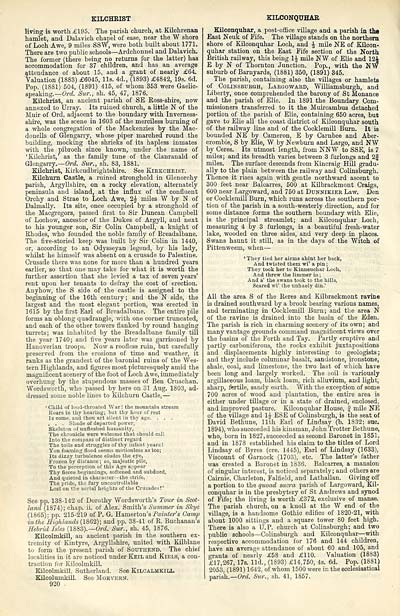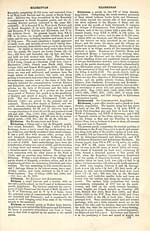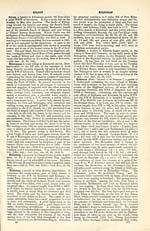Ordnance gazetteer of Scotland
(928) Page 920
Download files
Complete book:
Individual page:
Thumbnail gallery: Grid view | List view

KILCHRIST
living is worth £195. The parish church, at Kilchrenan
hamlet, and Dalavieh chapel of ease, near the W shore
of Loch Awe, 9 miles SSW, were both built about 1771.
There are two public schools — Ardchonnel and Dalavieh.
The former (there being no returns for the latter) has
accommodation for 37 children, and has an average
attendance of about 15, and a grant of nearly £64.
Valuation (1883) £6045, lis. 4d., (1893) £4842, 19s. 6d.
Pop. (1881) 504, (1891) 415, of whom 353 were Gaelic-
speaking.— Ord. Sur., sh. 45, 47, 1876.
Kilchrist, an ancient parish of SE Ross-shire, now
annexed to Urray. Its ruined church, a little N of the
JIuir of Ord, adjacent to the boundary with Inverness-
shire, was the scene in 1603 of the merciless burning of
a whole congregation of the Mackenzies by the Mac-
donells of Glengarry, whose piper marched round the
building, mocking the shrieks of its hapless inmates
with the pibroch since known, under the name of
'Kilchrist,' as the family tune of the Clanranald of
Glengarry.— Ord. Stir., sh. 83, 1881.
Kilchrist, Kirkcudbrightshire. See Kikkchkist.
Kilehurn Castle, a ruined stronghold in Glenorchy
parish, Argyllshire, on a rocky elevation, alternately
peninsula and island, at the influx of the confluent
Orchy and Strae to Loch Awe, 2J miles W by N of
Dalmally. Its site, once occupied by a stronghold of
the Macgregors, passed first to Sir Duncan Campbell
of Lochow, ancestor of the Dukes of Argyll, and next
to his younger son, Sir Colin Campbell, a knight of
Rhodes, who founded the noble family of Breadalbane.
The five-storied keep was built by Sir- Colin in 1440,
or, according to an Odysseyan legend, by his lady,
whilst he himself was absent on a crusade to Palestine.
Crusade there was none for more than a hundred years
earlier, so that one may take for what it is worth the
further assertion that she levied a tax of seven years'
rent upon her tenants to defray the cost of erection.
Anyhow, the S side of the castle is assigned to the
beginning of the 16th century; and the N side, the
largest and the most elegant portion, was erected in
1615 by the first Earl of Breadalbane. The entire pile
forms an oblong quadrangle, with one corner truncated,
and each of the other towers flanked by round hanging
turrets; was inhabited by the Breadalbane family till
the year 1740; and five years later was garrisoned by
Hanoverian troops. Now a roofless ruin, but carefully
preserved from the erosions of time and weather, it
ranks as the grandest of the baronial ruins of the Wes-
tern Highlands, and figures most picturesquely amid the
magnificent scenery of the foot of Loch Awe, immediately
overhung by the stupendous masses of Ben Cruachan.
Wordsworth, who passed by here on 31 Aug. 1803, ad-
dressed some noble lines to Kilehurn Castle, —
' Child of loud-throated War! the mountain stream
Roars in thy hearing; but thy hour of rest
Is come, and thou art silent in thy age. . . .
. . . Shade of departed power,
Skeleton of unfleshed humanity,
The chronicle were welcome that should call
Into the compass of distinct regard
The toils and struggles of thy infant years!
Yon foaming flood seems motionless as ice;
Its dizzy turbulence eludes the eye,
Frozen by distance ; so, majestic pile.
To the perception of this Age appear
Thy fierce beginnings, softened and subdued,
And quieted in character — the strife,
The pride, the fury uncontrollable
Lost on the aerial heights of the Crusades!'
See pp. 138-142 of Dorothy Wordsworth's Tour in Scot-
land (1874); chap. ii. of Alex. Smith's Summer in Slcye
(1865); pp. 215-219 of P. G. Hamerton's Painter's Camp
in the Highlands (1862); and pp. 38-41 of R. Buchanan's
Hebrid Isles (1883).— Ord. Sur., sh. 45, 1876.
Kilcolmkill, an ancient parish in the southern ex-
tremity of Krntyre, Argyllshire, united with Kilblane
to form the present parish of Southend. The chief
localities in it are noticed nnder Keil and Kiels, a con-
traction for Kilcolmkill.
Kilcolmkill, Sutherland. See Kilcalmkill.
Kilcolumkill. See Morvern.
920
KILCONQUHAR
Kilconquhar, a post-office village and a parish in the
East Neuk of Fife. The village stands on the northern
shore of Kilconquhar Loch, and £ mile NE of Kilcon-
quhar station on the East Fife section of the North
British railway, this being 1J mile NW of Elie and 12J
E by N of Thornton Junction. Pop., with the NW
suburb of Barnyards, (1881) 350, (1891) 345.
The parish, containing also the villages or hamlets
of Colinsburgh, Largoward, Williamsburgh, and
Liberty, once comprehended the barony of St Monance
and the parish of Elie. In 1891 the Boundary Com-
missioners transferred to it the Muircambus detached
portion of the parish of Elie, containing 650 acres, but
gave to Elie all the coast district of Kilconquhar south
of the railway line and of the Cocklemill Burn. It is
bounded NE by Cameron, E by Carnbee and Aber-
crombie, S by Elie, W by Newburn and Largo, and NW
by Ceres. Its utmost length, from NNW to SSE, is 7
miles; and its breadth varies between 3 furlongs and 2f
miles. The surface descends from Kincraig Hill gradu-
ally to the plain between the railway and Colinsburgh.
Thence it rises again with gentle northward ascent to
300 feet near Balcarres, 500 at Kilbrackmont Craigs,
600 near Largoward, and 750 at Dunnikier Law. Den
or Cocklemill Burn, which runs across the southern por-
tion of the parish in a south-westerly direction, and for
some distance forms the southern boundary with Elie,
is the principal streamlet; and Kilconquhar Loch,
measuring 4 by 3 furlongs, is a beautiful fresh-water
lake, wooded on three sides, and very deep in places.
Swans haunt it still, as in the days of the Witch of
Pittenweem, when —
' They tied her airms ahint her back,
And twisted them wi 1 a pin ;
They took her to Kinneuchar Loch,
And threw the limmer in ;
And a' the swans took to the bills,
Scared wi' the unhaely din.'
All the area S of the Reres and Kilbrackmont ravine
is drained southward by a brook bearing various names,
and terminating in Cocklemill Burn; and the area N
of the ravine is drained into the basin of the Eden.
The parish is rich in charming scenery of its own; and
many vantage grounds command magnificent views over
the basins of the Forth and Tay. Partly eruptive and
partly carboniferous, the rocks exhibit juxtapositions
and displacements highly interesting to geologists;
and they include columnar basalt, sandstone, ironstone,
shale, coal, and limestone, the two last of which have
been long and largely worked. The soil is variously
argillaceous loam, black loam, rich alluvium, and light,
sharp, fertile, sandy earth. With the exception of some
700 acres of wood and plantation, the entire area is
either under tillage or in a state of drained, enclosed,
and improved pasture. Kilconquhar House, f mile NE
of the village and lj ESE of Colinsburgh, is the seat of
David Bethune, 11th Earl of Lindsay (b. 1832; sue.
1894), who succeeded his kinsman, John Trotter Bethune,
who, born in 1827, succeeded as second Baronet in 1851,
and in 1878 established his claim to the titles of Lord
Lindsay of Byres (ere. 1445), Earl of Lindsay (1633),
Viscount of Garnock (1703), etc. The latter's father
was created a Baronet in 1836. Balcarres, a mansion
of singular interest, is noticed separately; and others are
Cairnie, Charleton, Falfield, and Lathallan. Giving off
a portion to the quoad sacra parish of Largoward, Kil-
conquhar is in the presbytery of St Andrews and synod
of Fife; the living is worth £372, exclusive of manse.
The parish church, on a knoll at the W end of the
village, is a handsome Gothic edifice of 1820-21, with
about 1000 sittings and a square tower 80 feet high.
There is also a U.P. ehureh at Colinsburgh; and two
public schools — Colinsburgh and Kilconquhar — with
respective accommodation for 176 and 144 children,
have an average attendance of about 60 and 105, and
grants of nearly £58 and £110. Valuation (1883)
£17,267, 17s. lid., (1893) £14,750, 4s. 6d. Pop. (1881)
2053, (1891) 1642, of whom 1500 were in the ecclesiastical
parish. — Ord. Sur., sh. 41, 1857.
living is worth £195. The parish church, at Kilchrenan
hamlet, and Dalavieh chapel of ease, near the W shore
of Loch Awe, 9 miles SSW, were both built about 1771.
There are two public schools — Ardchonnel and Dalavieh.
The former (there being no returns for the latter) has
accommodation for 37 children, and has an average
attendance of about 15, and a grant of nearly £64.
Valuation (1883) £6045, lis. 4d., (1893) £4842, 19s. 6d.
Pop. (1881) 504, (1891) 415, of whom 353 were Gaelic-
speaking.— Ord. Sur., sh. 45, 47, 1876.
Kilchrist, an ancient parish of SE Ross-shire, now
annexed to Urray. Its ruined church, a little N of the
JIuir of Ord, adjacent to the boundary with Inverness-
shire, was the scene in 1603 of the merciless burning of
a whole congregation of the Mackenzies by the Mac-
donells of Glengarry, whose piper marched round the
building, mocking the shrieks of its hapless inmates
with the pibroch since known, under the name of
'Kilchrist,' as the family tune of the Clanranald of
Glengarry.— Ord. Stir., sh. 83, 1881.
Kilchrist, Kirkcudbrightshire. See Kikkchkist.
Kilehurn Castle, a ruined stronghold in Glenorchy
parish, Argyllshire, on a rocky elevation, alternately
peninsula and island, at the influx of the confluent
Orchy and Strae to Loch Awe, 2J miles W by N of
Dalmally. Its site, once occupied by a stronghold of
the Macgregors, passed first to Sir Duncan Campbell
of Lochow, ancestor of the Dukes of Argyll, and next
to his younger son, Sir Colin Campbell, a knight of
Rhodes, who founded the noble family of Breadalbane.
The five-storied keep was built by Sir- Colin in 1440,
or, according to an Odysseyan legend, by his lady,
whilst he himself was absent on a crusade to Palestine.
Crusade there was none for more than a hundred years
earlier, so that one may take for what it is worth the
further assertion that she levied a tax of seven years'
rent upon her tenants to defray the cost of erection.
Anyhow, the S side of the castle is assigned to the
beginning of the 16th century; and the N side, the
largest and the most elegant portion, was erected in
1615 by the first Earl of Breadalbane. The entire pile
forms an oblong quadrangle, with one corner truncated,
and each of the other towers flanked by round hanging
turrets; was inhabited by the Breadalbane family till
the year 1740; and five years later was garrisoned by
Hanoverian troops. Now a roofless ruin, but carefully
preserved from the erosions of time and weather, it
ranks as the grandest of the baronial ruins of the Wes-
tern Highlands, and figures most picturesquely amid the
magnificent scenery of the foot of Loch Awe, immediately
overhung by the stupendous masses of Ben Cruachan.
Wordsworth, who passed by here on 31 Aug. 1803, ad-
dressed some noble lines to Kilehurn Castle, —
' Child of loud-throated War! the mountain stream
Roars in thy hearing; but thy hour of rest
Is come, and thou art silent in thy age. . . .
. . . Shade of departed power,
Skeleton of unfleshed humanity,
The chronicle were welcome that should call
Into the compass of distinct regard
The toils and struggles of thy infant years!
Yon foaming flood seems motionless as ice;
Its dizzy turbulence eludes the eye,
Frozen by distance ; so, majestic pile.
To the perception of this Age appear
Thy fierce beginnings, softened and subdued,
And quieted in character — the strife,
The pride, the fury uncontrollable
Lost on the aerial heights of the Crusades!'
See pp. 138-142 of Dorothy Wordsworth's Tour in Scot-
land (1874); chap. ii. of Alex. Smith's Summer in Slcye
(1865); pp. 215-219 of P. G. Hamerton's Painter's Camp
in the Highlands (1862); and pp. 38-41 of R. Buchanan's
Hebrid Isles (1883).— Ord. Sur., sh. 45, 1876.
Kilcolmkill, an ancient parish in the southern ex-
tremity of Krntyre, Argyllshire, united with Kilblane
to form the present parish of Southend. The chief
localities in it are noticed nnder Keil and Kiels, a con-
traction for Kilcolmkill.
Kilcolmkill, Sutherland. See Kilcalmkill.
Kilcolumkill. See Morvern.
920
KILCONQUHAR
Kilconquhar, a post-office village and a parish in the
East Neuk of Fife. The village stands on the northern
shore of Kilconquhar Loch, and £ mile NE of Kilcon-
quhar station on the East Fife section of the North
British railway, this being 1J mile NW of Elie and 12J
E by N of Thornton Junction. Pop., with the NW
suburb of Barnyards, (1881) 350, (1891) 345.
The parish, containing also the villages or hamlets
of Colinsburgh, Largoward, Williamsburgh, and
Liberty, once comprehended the barony of St Monance
and the parish of Elie. In 1891 the Boundary Com-
missioners transferred to it the Muircambus detached
portion of the parish of Elie, containing 650 acres, but
gave to Elie all the coast district of Kilconquhar south
of the railway line and of the Cocklemill Burn. It is
bounded NE by Cameron, E by Carnbee and Aber-
crombie, S by Elie, W by Newburn and Largo, and NW
by Ceres. Its utmost length, from NNW to SSE, is 7
miles; and its breadth varies between 3 furlongs and 2f
miles. The surface descends from Kincraig Hill gradu-
ally to the plain between the railway and Colinsburgh.
Thence it rises again with gentle northward ascent to
300 feet near Balcarres, 500 at Kilbrackmont Craigs,
600 near Largoward, and 750 at Dunnikier Law. Den
or Cocklemill Burn, which runs across the southern por-
tion of the parish in a south-westerly direction, and for
some distance forms the southern boundary with Elie,
is the principal streamlet; and Kilconquhar Loch,
measuring 4 by 3 furlongs, is a beautiful fresh-water
lake, wooded on three sides, and very deep in places.
Swans haunt it still, as in the days of the Witch of
Pittenweem, when —
' They tied her airms ahint her back,
And twisted them wi 1 a pin ;
They took her to Kinneuchar Loch,
And threw the limmer in ;
And a' the swans took to the bills,
Scared wi' the unhaely din.'
All the area S of the Reres and Kilbrackmont ravine
is drained southward by a brook bearing various names,
and terminating in Cocklemill Burn; and the area N
of the ravine is drained into the basin of the Eden.
The parish is rich in charming scenery of its own; and
many vantage grounds command magnificent views over
the basins of the Forth and Tay. Partly eruptive and
partly carboniferous, the rocks exhibit juxtapositions
and displacements highly interesting to geologists;
and they include columnar basalt, sandstone, ironstone,
shale, coal, and limestone, the two last of which have
been long and largely worked. The soil is variously
argillaceous loam, black loam, rich alluvium, and light,
sharp, fertile, sandy earth. With the exception of some
700 acres of wood and plantation, the entire area is
either under tillage or in a state of drained, enclosed,
and improved pasture. Kilconquhar House, f mile NE
of the village and lj ESE of Colinsburgh, is the seat of
David Bethune, 11th Earl of Lindsay (b. 1832; sue.
1894), who succeeded his kinsman, John Trotter Bethune,
who, born in 1827, succeeded as second Baronet in 1851,
and in 1878 established his claim to the titles of Lord
Lindsay of Byres (ere. 1445), Earl of Lindsay (1633),
Viscount of Garnock (1703), etc. The latter's father
was created a Baronet in 1836. Balcarres, a mansion
of singular interest, is noticed separately; and others are
Cairnie, Charleton, Falfield, and Lathallan. Giving off
a portion to the quoad sacra parish of Largoward, Kil-
conquhar is in the presbytery of St Andrews and synod
of Fife; the living is worth £372, exclusive of manse.
The parish church, on a knoll at the W end of the
village, is a handsome Gothic edifice of 1820-21, with
about 1000 sittings and a square tower 80 feet high.
There is also a U.P. ehureh at Colinsburgh; and two
public schools — Colinsburgh and Kilconquhar — with
respective accommodation for 176 and 144 children,
have an average attendance of about 60 and 105, and
grants of nearly £58 and £110. Valuation (1883)
£17,267, 17s. lid., (1893) £14,750, 4s. 6d. Pop. (1881)
2053, (1891) 1642, of whom 1500 were in the ecclesiastical
parish. — Ord. Sur., sh. 41, 1857.
Set display mode to: Large image | Transcription
Images and transcriptions on this page, including medium image downloads, may be used under the Creative Commons Attribution 4.0 International Licence unless otherwise stated. ![]()
| Gazetteers of Scotland, 1803-1901 > Ordnance gazetteer of Scotland > (928) Page 920 |
|---|
| Permanent URL | https://digital.nls.uk/97404382 |
|---|

